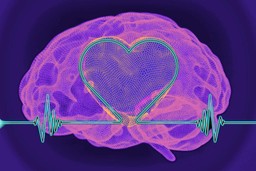Emotional power is at the heart of psychedelics. These experiences are transformative when they include our most important feelings. Psychedelic states can change reality because our reality is a mental construction.
We’re glib about what’s real. We marvel at new visions, especially if they’re attractive, but we have not considered what it means to be grounded or stable. We talk about integrating a psychedelic experience as something new to believe in. However, there’s little talk about what our bodies are prepared for.
Disruptive experiences challenge what you know. Are you ready for change? Are you prepared to recover your balance? Do you even know what balance means?
Our mind is built on memories, ideas, and emotions, but our bodies are built on rhythms. We’re aware of external rhythms, and we coordinate ourselves with them, but of greater importance are our internal rhythms. If you cannot support certain internal rhythms, you’ll die in a heartbeat.
We used to think the heart was a primary organ of the body, but with neural imaging, immunology, and epigenetics, we’ve retired this as a poetic story. It turns out we were correct: the heart plays an integral role in coordinating our entire system. The heart is not a solitary organ, but it is also not a driver. It is more like a governor, a broadcaster of timing and coordination. Our hearts are not pumps; they’re clocks (Oaklander, 2020).
Even that is not yet clear. We don’t yet know how much of the synchrony of our organ systems is signaled by our heart and how much of our system’s synchrony is reflected in it. It’s becoming clear that the quaint and ancient theory of pulses from Traditional Chinese Medicine has a reality that’s yet to be understood.
The Experience of Rhythm
We talk about psychedelics as catalysts of singular experiences, and we hold these experiences separate from our everyday lives. We might say these experiences allow us to see things differently or that they break up our normal thought patterns. And, we conceive of these experiences as events that start and stop at well-defined times, as this is how we think of the world.
Reality has rhythmic elements, and our lives do too. Rhythm is probably more important than singular events in establishing continuity. A dislocating event changes our rhythm—perhaps even permanently—but it’s the enduring rhythms that define our lives, not the singular events. Because the topic here is rhythm, it’s important to think rhythmically and to recognize that until we recognize the central role that rhythm plays, we may not either understand or change it.
Heart Rate Variability
Heart Rate Variability (HRV) refers to the many dimensions of your pulse. These reflect the coordination of your circulatory system and serve the needs of all your organs. Our pulse varies in response to our breath, to maintain our blood pressure, and in response to our level of arousal.
We learn to drive using one foot that presses alternatively on the accelerator and the brake. This is because we cannot trust our reflexes to press one or the other if we put one foot on each. In contrast, our sympathetic nervous system accelerates our heartbeat while our parasympathetic nervous system slows it down. Both are active at the same time and just like the problem we have with a foot on each pedal, these two aspects of our nervous system often interfere with controlling our pulse.
Good heart rate variability occurs when the heart rhythmically accelerates and decelerates in coordination with the chemistry of breathing and the needs of the body. Our breath paces our heart’s dominant variation, but there are metabolic and diurnal rhythms as well.
When we are anxious, fearful, manic, or depressed, our sympathetic and parasympathetic nervous systems are in conflict. As a result, our heart’s variance is irregular, and our metabolic function is impaired. Even if you suffer cardiac impairment, your nervous system still coordinates your heart with your system.
“(Comparing) patients with cardiovascular disease with a high heart-rate variability, those with a low heart rate variability had a 121% and 46% increased risk of all-cause death and cardiovascular events, respectively, during a follow-up of at least 1 year.”
Fang, Wu, & Tsai (2019)
“Heart rate variability seems to play a role in exceptional longevity.”
Hernández-Vincente et al. (2020)
Measuring HRV
At its simplest, you measure your heart rate as the time between beats. This gives you one number that varies over periods longer than a single beat. It’s easy to watch this measure of the heart rate as it increases on the inhale and decreases on the exhale. This is what’s supposed to happen: to beat faster when your lungs are inflating and slower when they’re deflating. The change is supposed to be gradual and smooth with each breath. For most of us, however, it is not as smooth as it could be.
At a more detailed level, our heartbeat has more structure than a simple drum beat because it is nothing like a drum. Not only do the heart’s four chambers execute a syncopated rhythm, but the electrical signals traveling through the heart execute microsecond rhythms that affect the shape of our pulse. Because parts of the heart have rhythms much faster than their main contraction, heart rate variability also has components of much shorter duration than a single beat.
Heart and Lungs
The heart’s coordination with breathing is the dominant component referred to as the low-frequency component of heart rate variability. A slower variation maintains blood pressure throughout the body. This is called the very low-frequency component of the heart’s rhythm. Rapid changes in one’s heart rate are driven by physical activity or the expectation of it, which could be a response to either exercise or fear. Because these changes happen rapidly, they’re called the high-frequency component of heart rate variability.
The heart rate variability—commonly referred to as a metric for exercise—is the low-frequency component that varies with your breath. Paced breathing is obviously important during exercise, but this overlooks the structures in the pulse that relate to mood and metabolic control. Low-frequency changes in your heart rate are things you can focus on during rest and meditation.
Monitoring HRV over a wider range of frequencies gives a better picture of your cardiac health and your nervous system’s ability to maintain balance. Beyond the easy connection between breath and heart rate, it’s neither easy to sense nor control our heart rate. Of all our intentional actions, it is our mood that affects our heart rate the most.
Training HRV
Muscles grow with use, and joints become more flexible with exercise. Our metabolism also grows in strength and flexibility when it’s called upon to respond in a coordinated fashion. You can learn better heart rate variability, and this can improve every aspect of your physical and mental health. But how do you exercise something that you’re not aware of controlling?
It turns out we’re doing this all the time. Life is a dynamic balance that’s out of equilibrium. Learning better balance is a matter of coordination and engagement. We improve when we’re aware of what’s happening; when we’re part of the process. Learning to improve your HRV is fairly easy if you can see it, and there are machines that can show it to us.
A range of health devices and exercise aids claim to monitor our HRV, but there is no single number to display that reflects it all. Most of these devices analyze our pulse and summarize some aspect of it, usually well after the fact. They do not tell you what your HRV is; they tell you what it was, and that’s only marginally helpful.
The Heart is Emotional
“Studies have found that HRV biofeedback (HRVB) does, in fact, produce improvement in a variety of physical and emotional conditions including anxiety, depression, hypertension, asthma, and pain, as well as improvement in various kinds of human performance including mental concentration and agility, athletics, dance, and music. The technique is easily learned and can be trained using inexpensive equipment, including several free smartphone applications. HRVB has been proposed as a psychotherapy component that specifically targets the neurovegetative components of emotional problems and may improve treatment effectiveness. Most people can achieve high-amplitude oscillations in HR after just a few minutes of training, and almost everyone can master the technique within one to four sessions of coaching.” — Paul Lehrer et al. (2020)
HVR monitoring is different from HVR training. Monitoring can help you establish better habits, while training teaches you to improve your skills. Monitors range from free to $100, while training tools range from $100 used to $400 new. I discuss different product options in this blog post.
HRV and Psychedelics
It’s taken some explanation to get to the point, but you need to understand HRV before you can apply it. There is a metabolic foundation that underlies the psychedelic experience, and the nature of the psychedelic experience depends on it.
Psychedelics stress your body and mind. They can change your metabolism and mood, and their effects can be long-lasting. There is much talk about the set and setting of the experience but almost no talk about preparation. I insist there are preparations to do and skills to learn before going down the psychedelic path.
How well you respond to the situation is not just a matter of the thoughts in your head. It’s also a question of balance in your body. HRV not only measures this, it governs it. The quality of your psychedelic experience—or any experience, really—depends on your ability to manage the rhythms within your pulse.
Prepare the Body
Just as you would not begin a gymnastic challenge without being strong and limber, you should not go headlong into a psychedelic challenge without being grounded, balanced, and resilient. Some of this is a matter of mindset, but much more can be done with training—and it doesn’t take much.
Heart rate variability training is simple, easy, and safe. Training devices remain more expensive than they could be, given that a simple PPG finger sensor costs one-tenth the price. But improving your HVR will help all aspects of your life, including your mood and longevity.
I’ve emphasized mind and body training since I began working with psychedelics three decades ago. Before science and allopathic medicine, the body-mind experience was not reduced to separate parts. Eastern, Indigenous, spiritual, and religious training has always emphasized working on the mind and body together.
Recognize that psychedelics are a mind-body experience that amplifies what you have more than they provide what you lack. Take them seriously; train yourself. Improve your heart rate variability, if for no other reason than it will extend your life.
Follow your Curiosity
Sign up to receive our free psychedelic courses, 45 page eBook, and special offers delivered to your inbox.References
Fang, C., Wu, L., & Tsai, S. (2020). Heart Rate Variability and Risk of All-Cause Death and Cardiovascular Events in Patients With Cardiovascular Disease: A Meta-Analysis of Cohort Studies. Biological Research For Nursing, 22 (1), 45–56. https://doi.org/10.1177/1099800419877442
Hernández-Vicente, A., Hernando, D., Santos-Lozano, A., Rodríguez-Romo, G., Vicente-Rodríguez, G., Pueyo, E., Bailón, R., and Garatachea, N. (2020 Sep 17). Heart Rate Variability and Exceptional Longevity. Frontiers in Physiology, 11 (566399). https://doi.org/10.3389/fphys.2020.566399
Lehrer, P., Kaur, K., Sharma, A., Shah, K., Huseby, R., Bhavsar, J., and Zhang, Y. (2020 May 8). Heart Rate Variability Biofeedback Improves Emotional and Physical Health and Performance: A Systematic Review and Meta Analysis. Appl Psychophysiol Biofeedback, 45, 109–129. https://doi.org/10.1007/s10484-020-09466-z
Oaklander, M. (2020, August 7). The Next Frontier of Personalized Medicine: Your Inner Clock. TIME. https://www.everand.com/article/471691284/The-Next-Frontier-Of-Personalized-Medicine-Your-Inner-Clock







